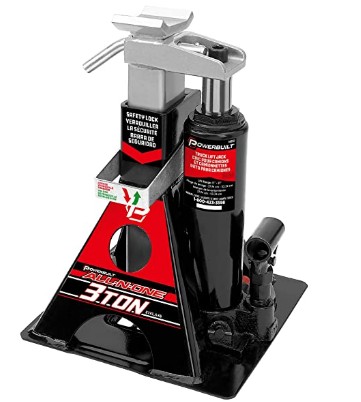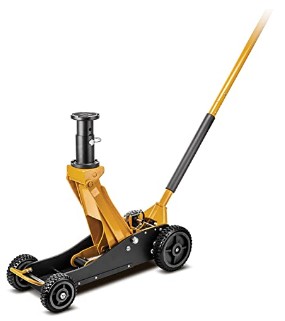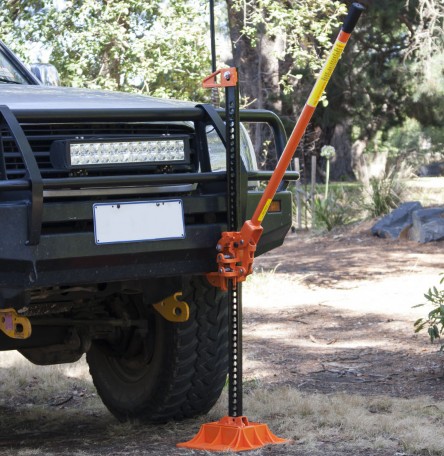Off-road rigs already come with a fantastic lift from the manufacturer. In most cases, this is at the very limit or even higher than what traditional emergency jack kits on regular sedans and SUVs can handle.
Once you start adding more ground clearance with a lift kit to a 4×4 that already has 10” between jacking points and the ground, you will need specialist jacks to get that vehicle off the ground for even a simple tire change.
That is why you lifted trucks strapping those big heavy hi-lift jacks somewhere on the roof rack or the tailgate. They’re not just for the looks. They’re needed to safely jack the truck for even the most minor jobs.
What Size of Jack Do I Need?
The most important specification to consider when buying the jack is how high it can lift and what type of jack it is.
The best lift to go for is 48”. This will fit most 4WD trucks. However, if you have a 6” lift and tires bigger than 33”, you will have to get a 60” lift jack.
What Type of Jack Should I Buy
Three jack types can safely lift your modified off-road truck.
- Bottle jacks
- Floor jacks
- Hi-Lift jacks
Bottle Jacks

Bottle jacks are, well, bottle like hydraulic jacks that are compact and highly portable. Despite their small size, they can offer impressive load-bearing capabilities and lift over considerable heights as long as you set them on a firm base.
They’re a perfect choice for on-pavement use and around your home garage for simple tasks or jacking up your truck to put it on jack stands.
When using it offroad, consider carrying some paver blocks to give a solid base or a 4×4 chunk of hardwood. Otherwise, the jack could tip on you, leading to a calamity.
Here are some of the best bottle jacks to use on your lifted truck
Floor Jacks

Floor jacks are bigger hydraulic units that are easier to position and use. Since the operator is always to the side of the truck, they are arguably safer than a bottle or scissor jacks.
Their stability and high lift range make them a perfect garage addition to people with lifted trucks.
Since they are bulky units and a bit useless while out on the road or the trail, they are best used within the garage. You could work around this by getting one with bigger wheels making it easier to roll about on uneven surfaces.
Some of the best floor jacks you could buy for your lifted Jeep include:
Hi-Lift Jack

Hi-Lift jacks are an indispensable 4×4 tool that will get you out of many tricky places in the trail. The jack could lift your truck, letting you work under it or change a tire. It will also raise a beached truck on the trail or give you the clearance you need to place some traction mats or rocks under the tire for more grip.
Apart from just lifting your car, you can use a high lift jack to winch yourself out of a messy situation if you don’t have an electric winch.
How Do Hi-Lift Jacks Work?
Hi-lift jacks consist of the climbing pin assembly and a long steel bar. Every time you work the lever, one pin lodges the runner into place by jamming into one of the holes as another pin retracts and moves to the next hole as you work the handle.
The process repeats until you’ve lifted or lowered your lifted truck as much as you want. You need to be strong and hold the handle at the furthest end since you use leverage and weight to lift the vehicle.
The only safety feature is a shear pin that jams the jack in place if something breaks, preventing your car from dropping to the ground. This rarely happens since the units are made of high-quality iron with a lifting capacity of 7000 pounds, which is more than most offroad rigs weigh.
ProTip: Hi-Lift jacks can be dangerous if misused. Before deploying it out in the field, take time to understand your jack and safe use policies to avoid injury.
- Hi-Lift Jack HL485 48″ Hi-Lift Red All Cast Jack
- BIG RED TRA8335 Torin 33″ Ratcheting Off-Road Utility Farm Jack
Which Jack Should I Use for My Lifted Truck?
While all the above jack types are compatible with your lifted truck, they’re all designed with different applications in mind.
A bottle jack is the perfect easy-to-use unit when on the road for menial tasks like lifting the truck to change a tire or inspecting the undercarriage. Use it with jack stands for extra safety.
The floor jack is a safer and more versatile unit you can use in your garage or driveway when you want to do more extended work under your truck. You can use it under the differential or subframe to evenly lift a truck – something you shouldn’t try with a bottle jack.
A high-lift jack is a rudimentary tool that will come in handy in an assortment of lifting or pulling tasks when off-roading. They’re designed to help raise your truck over or off obstacles, even though you can still use them to access your truck’s belly or to change a tire.
Where to Place a Jack on a Lifted Truck
While the subframe of your truck might seem all strong and sturdy (and don’t get me wrong, it is), you have to ensure that you place your jack and jack stands at the designated jack points for safety.
The jack points are not only strong enough to support the truck but also the right balance points to prevent your vehicle from shifting or tipping over as you lift.
- You will find jack points on each side of the truck just behind the front wheels and in front of the back wheels.
- When lifting one side, use the jack point closest to the wheel
- If you want to lift the entire truck up, place the jack stands on the jack points furthest from the wheels
- Using a rubber jack saddle could give you a firmer grip with the jack point and prevent slippage once the vehicle starts going up.
ProTip: If you use your Hi-Lift jack to help unbeach your truck or clear obstacles, you can be creative and use straps around wheels or clamps on the subframe or slide bars. Monitor everything closely and ensure that the jack point is strong enough to support the weight.
If your truck has a solid axle differential combo, you can find lift points along the axle. The axle is strong enough to support the vehicle and can be a perfect spot for your jack.
Nonetheless, using the designated jack point for your truck model is safer. Consult your user manual or check online for the specific points in your vehicle model for extra safety.
Check this too: How To Reduce Road Noise From Tires
Never Lift Your Truck More Than It’s Necessary
Regardless of what jack you are using, ensure that you jack your car only as high as you have to. Every inch your vehicle is off the ground gives it more potential energy. The more the potential energy, the more the damage it can do if things go wrong and it drops off the jack or jack stands.
Don’t lift your car higher than an inch or two over the obstacle you want to clear. For instance, when changing a tire, just lift it such that you have an inch or two between the bottom of the tire and the ground.
You will save energy and end up with a safer setting since you did not push your vehicle unnecessarily high.
